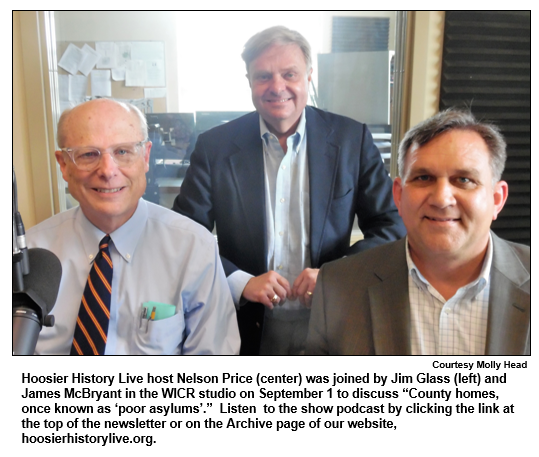Saturdays, noon to 1 p.m. ET on WICR 88.7 FM.
Or listen live from anywhere on WICR Online!
Our call-in number during the show: (317) 788-3314

September 8, 2018
Early French influence in the territory that became Indiana

Indiana's French heritage isn't always as obvious as that of ethnic groups such as the Germans and Irish, who arrived in the Midwest in far larger numbers during the peak years of European immigration into Indiana in the the mid 1800s.
Few if any areas of Indiana have a concentrated population that can boast of French ancestry, and French cultural centers akin to the Germanic Atheneum are few in number. Alas, aside from the annual French Market festival in Indianapolis, it can even be hard to find authentic French cuisine in the Hoosier capital.
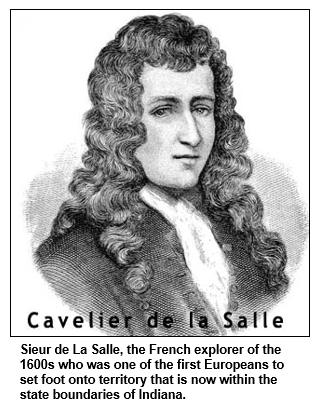
In fact, the French were the first Europeans to explore and settle in what would become Indiana, and their complex relationship with the Native American tribes - as well as their later rivalry with the British - set the course for historic developments that resound unto this day.
To take a look into the legacy of French explorers, fur traders, and missionaries in Indiana, Hoosier History Live associate producer and guest host Mick Armbruster will delve into questions about the early French presence in Indiana. What brought the French to the region before any other Europeans? How did they interact with the Native American tribes who were already living here? How did the French mediate conflicts between those tribes, and later come into conflict themselves with westward-expanding British colonists?
And what is the legacy of the early French explorers, fur traders and missionaries today, given that so few of their descendents remain in the state?

And even if you remember covering this territory in your fourth grade Indiana History class, Richard may have some surprises for you. For example, he'll talk about the Code Noir that governed the French treatment of enslaved Africans in the New World. He'll also expound upon the role played by the Jesuit missionaries in the French colonial settlements.

Bob grew up knowing almost nothing about his family history until he started looking into his genealogy as an adult. Among his surprising discoveries: he had ancestors who had participated in the American Revolution and had been granted land for their service in the fight for Independence.
Researching his family history has been "like an onion," Bob says. "You peel back a layer and find something extraordinary in the next layer."
History Mystery
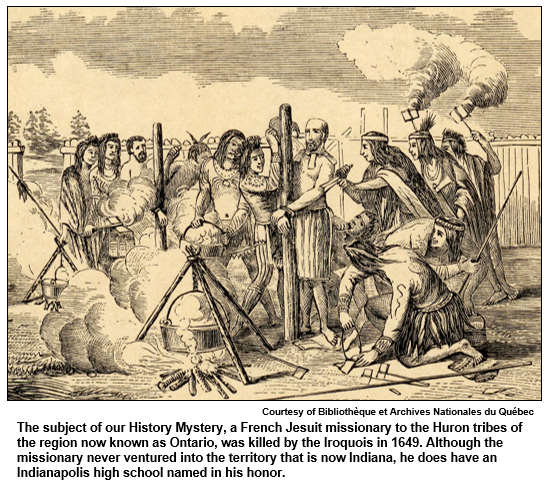
Among the earliest representatives of French culture in North America were Jesuit missionaries, who sought to bring the teachings of the Catholic Church to the Native Americans.
The subject of this week's History Mystery is a Jesuit missionary who arrived in New France (what we now call Canada) in 1625. He spent most of the rest of his life among the Huron Indians, studying their language, culture and religion and attempting to convert them to Christianity. He was killed in 1649 when a band of Iroquois attacked the Huron mission where he was staying.
Although the Jesuit missionary in question never appears to have set foot in what is now the Hoosier state, he does have an Indiana connection: A Jesuit Preparatory high school in Indianapolis that opened in 1962 carries his name.
Question: Who is the 17th century French missionary for whom a Jesuit high school in Indianapolis is named?
The call-in number is (317) 788-3314. Please do not call in to the show until you hear Mick pose the question on the air, and please do not try to win if you have won any other prize on WICR during the last two months. You must be willing to give your first name to our engineer, you must answer the question correctly on the air and you must be willing to give your mailing address to our engineer so we can mail the prize pack to you. The prize is 4 passes to the Indiana History Center, courtesy of the Indiana Historical Society, as well as a copy of the book The American Vine-Dresser's Guide: A Treatise on the Cultivation of the Vine, and the Process of Wine Making Adapted to the Soil and Climate of the United States. The book was originally published in 1826 and written by John James DeFour, who established the first commercially successful vineyard in America in Switzerland County, Indiana, in 1798. Courtesy of the Switzerland County Historical Museum.
Roadtrip: French-Swiss history in Switzerland County
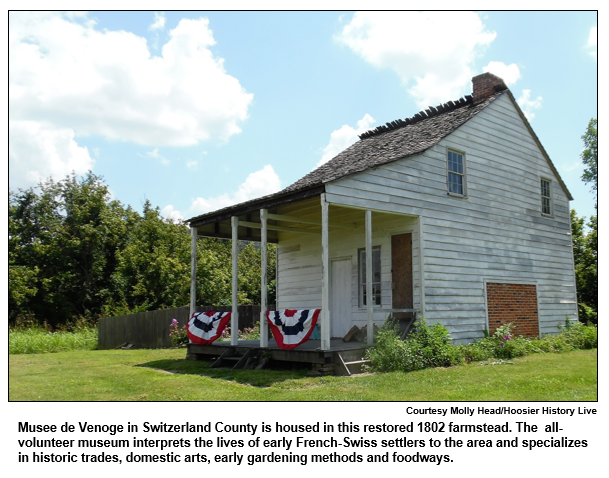
Guest Roadtripper Martha Bladen, Director of the Switzerland County Historical Museum, invites us to come visit two houses in southeastern Indiana that reflect French/Swiss influence. Settlers to the area began arriving in the early 1800s from the Lake Geneva area of Switzerland and spoke French.
The Thiebaud Farmstead sits on 165 acres originally settled by Frederick and Harriet Thiebaud in 1817. It overlooks the Ohio River and has been restored by the Switzerland County Historical Society. Visitors can learn about many aspects of Indiana's agricultural history; exhibits include the restored haypress barn, smokehouse and granary.
The second home reflecting French heritage is the tiny Musee de Venoge, which has been restored on the 30 acre tract of the Louis Gex-Oboussier farmstead that was a portion of the original 1802 French-Swiss settlement. To learn more about the Venoge farm, check out their newsletter, La Gazette Helvetique, published twice yearly (in English, not French!), which chronicles the museum's work.
And don’t miss the Rural Heritage Tour of both of these homes on October 6 and 7, where you can experience hearth cooking, heirloom gardens, period music, historic trades and a haypress demonstration at the Thiebaud Farmstead. Martha tells us that the cost of the tour is only $2.00!
"County homes" show hits a home run!
Post our podcasts, please!
As readers have surely noticed, we are posting links to weekly podcasts of Hoosier History Live at the top of our newsletter and website, generally on the Friday following the live Saturday show. Feel free to copy and paste the links to our podcasts anywhere you connect with others on the Internet. Tweet it to your followers and post it to your FaceBook friends - we love social media! We do request that you not edit or alter the audio files because they contain underwriter credits, and we need their support!
When you do post a podcast link, we appreciate it if you put "Courtesy of Hoosier History Live" and a link to our website www.hoosierhistorylive.org next to the post. As with all media, the more people know about us, the better.
Nelson Price, host and historian
Molly Head, producer/project manager, (317) 927-9101
Michael Armbruster, associate producer
Cheryl Lamb, administrative manager
Richard Sullivan, senior tech consultant
Pam Fraizer, graphic designer
Garry Chilluffo, special events consultant

Please tell our sponsors that you appreciate their support!

 Acknowledgments to Monomedia, Visit Indy, WICR-FM, Fraizer Designs, Heritage Photo & Research Services, Henri Pensis, Chris Shoulders, Aaron Duvall, and many other individuals and organizations. We are an independently produced program and are self-supporting through organizational sponsorship, and by individual contribution at the yellow button on our newsletter or website. For organizational sponsorship, which includes logos, links, and credits in the show, contact Molly Head at (317) 927-9101 or email her at molly@hoosierhistorylive.org. And any of our podcasts can be sponsored for a nominal fee.
Acknowledgments to Monomedia, Visit Indy, WICR-FM, Fraizer Designs, Heritage Photo & Research Services, Henri Pensis, Chris Shoulders, Aaron Duvall, and many other individuals and organizations. We are an independently produced program and are self-supporting through organizational sponsorship, and by individual contribution at the yellow button on our newsletter or website. For organizational sponsorship, which includes logos, links, and credits in the show, contact Molly Head at (317) 927-9101 or email her at molly@hoosierhistorylive.org. And any of our podcasts can be sponsored for a nominal fee.
Thank you!
We'd like to thank the following recent, new and renewal contributors whose donations help make this show possible!
- Dave and Theresa Berghoff
- Ann S. Frick
- Adam Rickert
- Carol Bacon
September 15, 2018 - Upcoming
Early Mexican heritage in Indiana
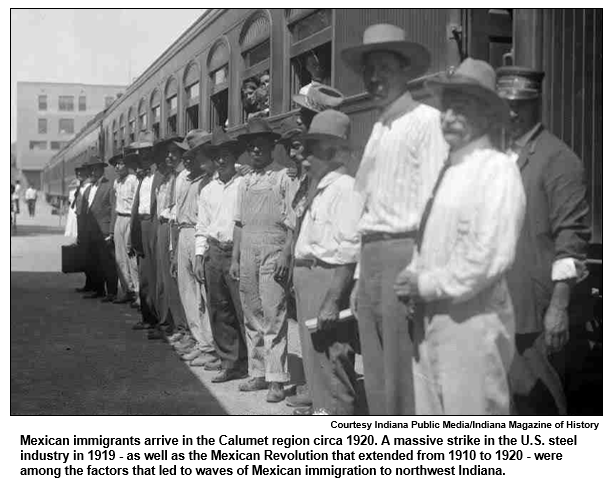
Although current immigration from Mexico has been in the news almost daily of late, how many Hoosiers know about the deep history of Mexican heritage in Indiana that began nearly 100 years ago?
With the start of Hispanic Heritage Month on Sept. 15 - and Mexican Independence Day on Sept. 16 - we will spotlight early immigration to Indiana and the roots of the state's population that has Mexican heritage. For a range of reasons, 1919 was a pivotal year for Mexican arrivals in the Hoosier state, according to Nicole Martinez-LeGrand.
Nicole, whose ancestors came from Mexico to the Indiana Harbor area of Lake County as early as 1918, is the coordinator of multicultural collections for the Indiana Historical Society. She has organized Be Heard: Latino Experiences in Indiana, an exhibit of early photos of - and artifacts associated with - Indiana's early Latino population, including a doll that belonged to her Mexican ancestors. The exhibit at the Eugene and Marilyn Glick Indiana History Center will continue through Nov. 3.
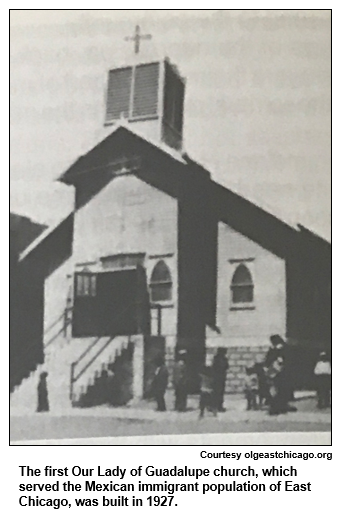
But that will be the primary focus. According to Nicole, a massive strike in the U.S. steel industry in 1919 - as well as the Mexican Revolution that extended from 1910 to 1920 - were among the factors that led to waves of Mexican immigration to northwest Indiana. Many settled in East Chicago and other communities in Lake County. Like Nicole's ancestors, they took jobs in the steel mills alongside waves of Eastern European immigrants.
Mexican immigrants helped raise funds for Our Lady of Guadalupe Church in East Chicago; in 1927, it opened as the first Latino Catholic Church in Indiana, according to Nicole's research. A ledger kept by Nicole's great-grandmother, who raised funds for construction of the church, and the family's storyline is featured in the Be Heard exhibit.
Other factors affecting the impact of early Mexican heritage in Indiana involved restrictions on Eastern European immigration to the U.S. after World War I. Enacted during the mid-1920s, those restrictions resulted in an increase in the percentages of Mexican immigrants. We explored the restrictions on Eastern Europeans in the 1920s during a radio show on July 7 about Ellis Island, immigration and Indiana (click here for the podcast).
© 2018 Hoosier History Live. All rights reserved.
|

